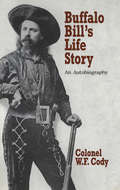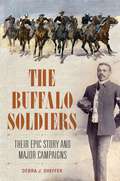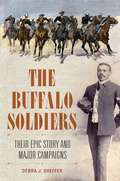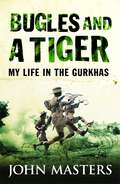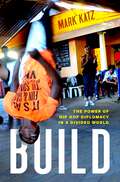- Table View
- List View
Buddhists, Shamans, and Soviets: Rituals of History in Post-Soviet Buryatia (Oxford Ritual Studies Series)
by Justine Buck QuijadaHistory in the Soviet Union was a political project. From the Soviet perspective, Buryats, an indigenous Siberian ethnic group, were a "backwards" nationality that was carried along on the inexorable march towards the Communist utopian future. When the Soviet Union ended, the Soviet version of history lost its power and Buryats, like other Siberian indigenous peoples, were able to revive religious and cultural traditions that had been suppressed by the Soviet state. In the process, they also recovered knowledge about the past that the Soviet Union had silenced. Borrowing the analytic lens of the chronotope from Bakhtin, Quijada argues that rituals have chronotopes which situate people within time and space. As they revived rituals, Post-Soviet Buryats encountered new historical information and traditional ways of being in time that enabled them to re-imagine the Buryat past, and what it means to be Buryat. Through the temporal perspective of a reincarnating Buddhist monk, Dashi-Dorzho Etigelov, Buddhists come to see the Soviet period as a test on the path of dharma. Shamanic practitioners, in contrast, renegotiate their relationship to the past by speaking to their ancestors through the bodies of shamans. By comparing the versions of history that are produced in Buddhist, shamanic and civic rituals, Buddhists, Shamans and Soviets offers a new lens for analyzing ritual, a new perspective on how an indigenous people grapples with a history of state repression, and an innovative approach to the ethnographic study of how people know about the past.
Buddhists, Shamans, and Soviets: Rituals of History in Post-Soviet Buryatia (Oxford Ritual Studies Series)
by Justine Buck QuijadaHistory in the Soviet Union was a political project. From the Soviet perspective, Buryats, an indigenous Siberian ethnic group, were a "backwards" nationality that was carried along on the inexorable march towards the Communist utopian future. When the Soviet Union ended, the Soviet version of history lost its power and Buryats, like other Siberian indigenous peoples, were able to revive religious and cultural traditions that had been suppressed by the Soviet state. In the process, they also recovered knowledge about the past that the Soviet Union had silenced. Borrowing the analytic lens of the chronotope from Bakhtin, Quijada argues that rituals have chronotopes which situate people within time and space. As they revived rituals, Post-Soviet Buryats encountered new historical information and traditional ways of being in time that enabled them to re-imagine the Buryat past, and what it means to be Buryat. Through the temporal perspective of a reincarnating Buddhist monk, Dashi-Dorzho Etigelov, Buddhists come to see the Soviet period as a test on the path of dharma. Shamanic practitioners, in contrast, renegotiate their relationship to the past by speaking to their ancestors through the bodies of shamans. By comparing the versions of history that are produced in Buddhist, shamanic and civic rituals, Buddhists, Shamans and Soviets offers a new lens for analyzing ritual, a new perspective on how an indigenous people grapples with a history of state repression, and an innovative approach to the ethnographic study of how people know about the past.
The Budget, The Land And The People.: The New Land Value Taxes Explained and Illustrated (Routledge Revivals)
by Lloyd GeorgeFirst published in 1909 , this book explored the Land Value Clauses of the Finance Bill issued in this year. Designed to be accessible for a common readership, Lloyd George in this book , on behalf of the Budget League, set forth the motives of the revised land values tax so to educate the public of Britain.
The Budget, The Land And The People.: The New Land Value Taxes Explained and Illustrated (Routledge Revivals)
by Lloyd GeorgeFirst published in 1909 , this book explored the Land Value Clauses of the Finance Bill issued in this year. Designed to be accessible for a common readership, Lloyd George in this book , on behalf of the Budget League, set forth the motives of the revised land values tax so to educate the public of Britain.
Budweisers into Czechs and Germans: A Local History of Bohemian Politics, 1848-1948 (PDF)
by Jeremy KingThis history of a single town in Bohemia casts new light on nationalism in Central Europe between the Springtime of Nations in 1848 and the Cold War. Jeremy King tells the story of both German and Czech-speaking Budweis/Budæjovice, which belonged to the Habsburg Monarchy until 1918, and then to Czechoslovakia, Hitler's Third Reich, and Czechoslovakia again. Residents, at first simply "Budweisers," or Habsburg subjects with mostly local loyalties, gradually became Czechs or Germans. Who became Czech, though, and who German? What did it mean to be one or the other? In answering these questions, King shows how an epochal, region-wide contest for power found expression in Budweis/Budæjovice not only through elections but through clubs, schools, boycotts, breweries, a remarkable constitutional experiment, a couple of riots, and much more. In tracing the nationalization of politics from small and sometimes comic beginnings to the genocide and mass expulsions of the 1940s, he also rejects traditional interpretive frameworks. Writing not a national history but a history of nationhood, both Czech and German, King recovers a nonnational dimension to the past. Embodied locally by Budweisers and more generally by the Habsburg state, that dimension has long been blocked from view by a national rhetoric of race and ethnicity. King's Czech-Habsburg-German narrative, in addition to capturing the dynamism and complexity of Bohemian politics, participates in broader scholarly discussions concerning the nature of nationalism.
Buffalo at the Crossroads: The Past, Present, and Future of American Urbanism
Buffalo at the Crossroads is a diverse set of cutting-edge essays. Twelve authors highlight the outsized importance of Buffalo, New York, within the story of American urbanism. Across the collection, they consider the history of Buffalo's built environment in light of contemporary developments and in relationship to the evolving interplay between nature, industry, and architecture.The essays examine Buffalo's architectural heritage in rich context: the Second Industrial Revolution; the City Beautiful movement; world's fairs; grain, railroad, and shipping industries; urban renewal and so-called white flight; and the larger networks of labor and production that set the city's economic fate. The contributors pay attention to currents that connect contemporary architectural work in Buffalo to the legacies established by its esteemed architectural founders: Richardson, Olmsted, Adler, Sullivan, Bethune, Wright, Saarinen, and others. Buffalo at the Crossroads is a compelling introduction to Buffalo's architecture and developed landscape that will frame discussion about the city for years to come.Contributors: Marta Cieslak, University of Arkansas - Little Rock; Francis R. Kowsky; Erkin Özay, University at Buffalo; Jack Quinan, University at Buffalo; A. Joan Saab, University of Rochester; Annie Schentag, KTA Preservation Specialists; Hadas Steiner, University at Buffalo; Julia Tulke, University of Rochester; Stewart Weaver, University of Rochester; Mary N. Woods, Cornell University; Claire Zimmerman, University of Michigan
Buffalo, Barrels, & Bourbon: The Story of How Buffalo Trace Distillery Became The World's Most Awarded Distillery
by F. Paul PacultLearn about one of the most impactful distilleries in American history in this comprehensive tale Buffalo, Barrels, & Bourbon tells the fascinating tale of the Buffalo Trace Distillery, from the time of the earliest explorations of Kentucky to the present day. Author and award-winning spirits expert F. Paul Pacult takes readers on a journey through history that covers the American Revolutionary War, U.S Civil War, two World Wars, Prohibition, and the Great Depression. Buffalo, Barrels, & Bourbon covers the pedigree and provenance of the Buffalo Trace Distillery: The larger-than-life personalities that over a century and a half made Buffalo Trace Distillery what it is today Detailed accounts on how many of the distillery’s award-winning and world-famous brands were created The impact of world events, including multiple depressions, weather-related events, and major conflicts, on the distillery Belonging on the shelf of anyone with an interest in American spirits and history, Buffalo, Barrels, & Bourbon is a compelling must-read.
Buffalo, Barrels, & Bourbon: The Story of How Buffalo Trace Distillery Became The World's Most Awarded Distillery
by F. Paul PacultLearn about one of the most impactful distilleries in American history in this comprehensive tale Buffalo, Barrels, & Bourbon tells the fascinating tale of the Buffalo Trace Distillery, from the time of the earliest explorations of Kentucky to the present day. Author and award-winning spirits expert F. Paul Pacult takes readers on a journey through history that covers the American Revolutionary War, U.S Civil War, two World Wars, Prohibition, and the Great Depression. Buffalo, Barrels, & Bourbon covers the pedigree and provenance of the Buffalo Trace Distillery: The larger-than-life personalities that over a century and a half made Buffalo Trace Distillery what it is today Detailed accounts on how many of the distillery’s award-winning and world-famous brands were created The impact of world events, including multiple depressions, weather-related events, and major conflicts, on the distillery Belonging on the shelf of anyone with an interest in American spirits and history, Buffalo, Barrels, & Bourbon is a compelling must-read.
Buffalo Bill in Bologna: The Americanization of the World, 1869-1922
by Robert W. Rydell Rob KroesWhen it comes to the production and distribution of mass culture, no country in modern times has come close to rivaling the success of America. From blue jeans in central Europe to Elvis Presley's face on a Republic of Chad postage stamp, the reach of American mass culture extends into every corner of the globe. Most believe this is a twentieth-century phenomenon, but here Robert W. Rydell and Rob Kroes prove that its roots are far deeper. Buffalo Bill in Bologna reveals that the process of globalizing American mass culture began as early as the mid-nineteenth century. In fact, by the end of World War I, the United States already boasted an advanced network of culture industries that served to promote American values. Rydell and Kroes narrate how the circuses, amusement parks, vaudeville, mail-order catalogs, dime novels, and movies developed after the Civil War—tools central to hastening the reconstruction of the country—actually doubled as agents of American cultural diplomacy abroad. As symbols of America's version of the "good life," cultural products became a primary means for people around the world, especially in Europe, to reimagine both America and themselves in the context of America's growing global sphere of influence. Paying special attention to the role of the world's fairs, the exporting of Buffalo Bill's Wild West show to Europe, the release of The Birth of a Nation, and Woodrow Wilson's creation of the Committee on Public Information, Rydell and Kroes offer an absorbing tour through America's cultural expansion at the turn of the century. Buffalo Bill in Bologna is thus a tour de force that recasts what has been popularly understood about this period of American and global history.
Buffalo Bill in Bologna: The Americanization of the World, 1869-1922
by Robert W. Rydell Rob KroesWhen it comes to the production and distribution of mass culture, no country in modern times has come close to rivaling the success of America. From blue jeans in central Europe to Elvis Presley's face on a Republic of Chad postage stamp, the reach of American mass culture extends into every corner of the globe. Most believe this is a twentieth-century phenomenon, but here Robert W. Rydell and Rob Kroes prove that its roots are far deeper. Buffalo Bill in Bologna reveals that the process of globalizing American mass culture began as early as the mid-nineteenth century. In fact, by the end of World War I, the United States already boasted an advanced network of culture industries that served to promote American values. Rydell and Kroes narrate how the circuses, amusement parks, vaudeville, mail-order catalogs, dime novels, and movies developed after the Civil War—tools central to hastening the reconstruction of the country—actually doubled as agents of American cultural diplomacy abroad. As symbols of America's version of the "good life," cultural products became a primary means for people around the world, especially in Europe, to reimagine both America and themselves in the context of America's growing global sphere of influence. Paying special attention to the role of the world's fairs, the exporting of Buffalo Bill's Wild West show to Europe, the release of The Birth of a Nation, and Woodrow Wilson's creation of the Committee on Public Information, Rydell and Kroes offer an absorbing tour through America's cultural expansion at the turn of the century. Buffalo Bill in Bologna is thus a tour de force that recasts what has been popularly understood about this period of American and global history.
Buffalo Bill in Bologna: The Americanization of the World, 1869-1922
by Robert W. Rydell Rob KroesWhen it comes to the production and distribution of mass culture, no country in modern times has come close to rivaling the success of America. From blue jeans in central Europe to Elvis Presley's face on a Republic of Chad postage stamp, the reach of American mass culture extends into every corner of the globe. Most believe this is a twentieth-century phenomenon, but here Robert W. Rydell and Rob Kroes prove that its roots are far deeper. Buffalo Bill in Bologna reveals that the process of globalizing American mass culture began as early as the mid-nineteenth century. In fact, by the end of World War I, the United States already boasted an advanced network of culture industries that served to promote American values. Rydell and Kroes narrate how the circuses, amusement parks, vaudeville, mail-order catalogs, dime novels, and movies developed after the Civil War—tools central to hastening the reconstruction of the country—actually doubled as agents of American cultural diplomacy abroad. As symbols of America's version of the "good life," cultural products became a primary means for people around the world, especially in Europe, to reimagine both America and themselves in the context of America's growing global sphere of influence. Paying special attention to the role of the world's fairs, the exporting of Buffalo Bill's Wild West show to Europe, the release of The Birth of a Nation, and Woodrow Wilson's creation of the Committee on Public Information, Rydell and Kroes offer an absorbing tour through America's cultural expansion at the turn of the century. Buffalo Bill in Bologna is thus a tour de force that recasts what has been popularly understood about this period of American and global history.
Buffalo Bill's British Wild West
by Alan GallopThe story of how William F. Cody, army scout, Indian fighter, stagecoach driver and buffalo hunter, became an acting sensation with his Wild West show, playing to millions of people in America and Europe for over 30 years. This account highlights the tours of Victorian and Edwardian Britain. Includes details of the many towns and villages visited by Buffalo Bill and how the residents reacted to this incredible spectacular. This entertaining account of Buffalo Bill's tours of Britain is richly illustrated, with many previously unpublished photographs, cartoons, and posters.
Buffalo Bill's Life Story: An Autobiography
by William Fredrick CodyStirring campfire tales of the Old West animate these memoirs of Colonel William F. Cody, better known as Buffalo Bill. In a personal narrative as thrilling and satisfying as the most colorful fiction, Cody takes readers on back trails through the frontier he knew and loved, a world that changed almost beyond recognition during his own lifetime. His exciting stories of buffalo hunts, adventures among the Indians, stagecoach travel, and riding with the Pony Express sparkle with cameos of historical figures such as Wild Bill Hickok and Generals Sherman, Sheridan, and Custer, the latter of whom he served as a scout. Cody's vivid yarns begin with his frontier boyhood and perilous rides through Indian territory as an 11-year-old cattlehand, and conclude with the glittering triumphs of his Wild West Show, a dramatic re-creation of Indian battles and frontier life that dazzled audiences throughout the eastern United States and Europe. In this book, Cody draws on his own first-hand experience to paint an unforgettable picture of a storied period in American history and his own role in it. Historians and other readers intrigued by tales of the Old West will find themselves spellbound by these lively and readable memoirs. Eight handsome illustrations by famed artist N. C. Wyeth complement the colorful text.
The Buffalo Soldiers: Their Epic Story and Major Campaigns
by Debra J. Ph.D.This riveting narrative focuses on the Buffalo Soldiers, tracing the legacy of black military service and its social, economic, and political impact from the colonial era through the end of the 19th century.This fascinating saga follows the story of the Buffalo Soldiers as they participated in key events in America's history. Author Debra J. Sheffer discusses the impetus for the earliest black military service, how that service led to the creation of the Buffalo Soldiers, and how these men—and one woman—continued to serve in the face of epic obstacles. The work celebrates their significant military contributions to the campaigns of the American frontier and other battles, their fighting experiences, and life on the plains.Starting with the American Revolution, the book traces the heroic journey of these legendary servicemen from the period when black Americans first sought full citizenship in exchange for military service to the integration of the military and the dissolution of all-black regiments. Several chapters highlight the special achievements of the 9th and 10th United States Cavalry and the 24th and 25th United States Infantry. The book also features the accomplishments—both of the unit and individuals—of the Buffalo Soldiers in battle and beyond.
The Buffalo Soldiers: Their Epic Story and Major Campaigns
by Debra J. Ph.D.This riveting narrative focuses on the Buffalo Soldiers, tracing the legacy of black military service and its social, economic, and political impact from the colonial era through the end of the 19th century.This fascinating saga follows the story of the Buffalo Soldiers as they participated in key events in America's history. Author Debra J. Sheffer discusses the impetus for the earliest black military service, how that service led to the creation of the Buffalo Soldiers, and how these men—and one woman—continued to serve in the face of epic obstacles. The work celebrates their significant military contributions to the campaigns of the American frontier and other battles, their fighting experiences, and life on the plains.Starting with the American Revolution, the book traces the heroic journey of these legendary servicemen from the period when black Americans first sought full citizenship in exchange for military service to the integration of the military and the dissolution of all-black regiments. Several chapters highlight the special achievements of the 9th and 10th United States Cavalry and the 24th and 25th United States Infantry. The book also features the accomplishments—both of the unit and individuals—of the Buffalo Soldiers in battle and beyond.
Buffalo Soldiers: The Colored Regulars in the United States Army (Classics In Black Studies)
by T. G. StewardFormed in 1866, the African-American army units known as Buffalo Soldiers acquired near-mythical status for their fortitude and courage. At the outbreak of the Spanish-American War in 1898, the Buffalo Soldiers were among the first units to depart for Cuba. Dr. T. G. Steward, who served as chaplain of the Twenty-fifth Infantry for 16 years, wrote this fascinating firsthand account of the Cuban campaign. Dr. Steward's narrative offers a wide-ranging view of black military history that covers the beginning of the Republic as well as the service of black regulars. Captivating episodes from the Spanish-American War include the rescue of Theodore Roosevelt's Rough Riders, the capture of the stone fort at El Caney, and service by black infantrymen as volunteer nurses in the yellow fever camps. Additional gripping firsthand testimony is provided by long excerpts from the diary of Sergeant Major Edward L. Baker of the 10th Cavalry Regiment, who was awarded the Medal of Honor. Formed in 1866, the African-American army units known as Buffalo Soldiers acquired near-mythical status for their fortitude and courage. This history by a chaplain of the Twenty-fifth Infantry includes firsthand accounts of the Spanish-American War, including the rescue of Theodore Roosevelt's Rough Riders, as well as an overview of African-American participation in prior wars and conflicts.
The Buffer Girls
by Margaret DickinsonThe Buffer Girls is an inspiring tale of love, heartache and ambition from bestselling author Margaret Dickinson.It is 1920 in the Derbyshire dales. The Ryan family are adjusting to life now that the war is over. Walter has returned home a broken man and so it falls to his son and daughter, Josh and Emily, to keep the family candle-making business going.The Ryan children grew up with Amy Clark, daughter of the village blacksmith, and Thomas 'Trip' Trippett, whose father owns a cutlery business in Sheffield. Romance blossoms for Josh and Amy while Emily falls in love with Trip, but she is unsure if the feeling is mutual. Martha Ryan is fiercely ambitious for her son and so she uproots her family to Sheffield, but all Josh wants is to continue the family business and marry Amy. As the Ryans do their best to adapt to city life, their friendly neighbour, Lizzie, helps Emily find employment asa Buffer Girl polishing cutlery at a local factory.It turns out that it is Emily who is best equipped to forge a career but, as time goes on, problems and even dangers arise that the Ryan family could not possibly have foreseen.
The Buffs (Men-at-Arms #10)
by Gregory Blaxland Michael YouensThe Buffs originated in 1572 from a company of 300 men raised from London trained bands sent to aid the Protestant cause in Holland. Upon their return to England, the Company re-formed as a single regiment, the Holland Regiment, which later became known as 'The Buffs'. In the years that followed, this highly esteemed regiment served in conflicts ranging from the Peninsular War to World Wars I and II. This book details the history of the Buffs from their inception to their demise as an independent unit in 1967, focusing particularly on their uniforms, including the distinctive dragon badge.
Bugatti Supercars: A Century of Genius
by Lance ColeIn a fresh view of Bugatti, this book frames the design highlights of a series of Bugatti supercars that colour the marque's journey from its origins as an early 'supercar' to its reborn reality as a modern 'hypercar'. These Bugatti's have been chosen to tell a story that uniquely covers the original Bugatti's and the very latest iterations of Bugatti. Joining the two Bugatti camps, old and new, together creates a new roadmap of Bugatti coverage that is essential reading for both those familiar with the marque and for more recent Bugatti enthusiasts across a wider motoring landscape. Blending engineering, styling, art and more, Bugatti's unique story has stretched over one hundred years, giving us cars that capture the soul through exquisite engineering and design. Illustrated with stunning photographs, many of which are previously unpublished, the seasoned enthusiast, the established aficionado and the younger generation of Bugatti newcomers are provided with an up-to-date album of Bugatti information. The text is a guide by which to enter and explore Bugatti and also a conversation about Bugatti details and delights for those with deeper knowledge of the marque.
Bugles and a Tiger: My life in the Gurkhas (W&N Military)
by John MastersThe first of John Master's evocative memoirs about life in the Gurkhas in India on the cusp of WWIIJohn Masters was a soldier before he became a bestselling novelist. He went to Sandhurst in 1933 at the age of eighteen and was commissioned into the 4th Gurkha Rifles in time to take part in some of the last campaigns on the turbulent north-west frontier of India.John Masters joined a Gurhka regiment on receiving his commission, and his depiction of garrison life and campaigning on the North-West Frontier has never been surpassed. BUGLES AND A TIGER is a matchless evocation of the British Army in India on the eve of the Second World War. Still very much the army depicted by Kipling, it stands on the threshold of a war that will transform the world. This book is the first of three volumes of autobiography that touched a chord in the post-war world.
Bugs, Drugs and Three-pin Plugs: Everyday Science, Simply Explained
by Andrew MorrisFor the millions who remain curious about the world around them, but gained little from science at school, this book offers a way forward. Based on live discussions with adults from all walks of life, each chapter begins with an everyday experience, like swallowing a pill or watching a bee on a flower. The main scientific ideas underlying each topic are then explored, so that understanding of a set of fundamental concepts builds up gradually throughout the book. In contrast to more traditional approaches to science learning, topics range freely across the subject areas. The story of Covid, for example includes aspects of biology, chemistry, mathematics and social behaviour. Plain English is used throughout and mathematical expressions are avoided. Key points are illustrated with clear diagrams and photographs. By drawing on questions and perspectives of ordinary people, the book offers an introduction to basic ideas in science as a whole, rather than any one particular subject. For the adult wishing to make good a gap in their understanding it provides a starting point for entering the rich world of popular science.
Bugs, Drugs and Three-pin Plugs: Everyday Science, Simply Explained
by Andrew MorrisFor the millions who remain curious about the world around them, but gained little from science at school, this book offers a way forward. Based on live discussions with adults from all walks of life, each chapter begins with an everyday experience, like swallowing a pill or watching a bee on a flower. The main scientific ideas underlying each topic are then explored, so that understanding of a set of fundamental concepts builds up gradually throughout the book. In contrast to more traditional approaches to science learning, topics range freely across the subject areas. The story of Covid, for example includes aspects of biology, chemistry, mathematics and social behaviour. Plain English is used throughout and mathematical expressions are avoided. Key points are illustrated with clear diagrams and photographs. By drawing on questions and perspectives of ordinary people, the book offers an introduction to basic ideas in science as a whole, rather than any one particular subject. For the adult wishing to make good a gap in their understanding it provides a starting point for entering the rich world of popular science.
Bühne und Möglichkeitsraum: Franz Lehárs »Das Land des Lächelns« am Aalto-Theater Essen, 2019 (Theater #163)
by Lukas Kretschmer»Es könnte alles auch ganz anders sein.« Vom Entwurf und Konzept bis zur Realisierung eines Bühnenbildes ergeben sich unterschiedliche Modellierungen von Möglichkeiten. Lukas Kretschmer dokumentiert den bühnenbildnerischen Entwurfsprozess zu Franz Lehárs Operette »Das Land des Lächelns« am Aalto-Theater Essen (2019), umgesetzt als künstlerische Forschung. Dabei ist der konkrete Bühnenraum des Theaters sowohl als Entscheidungsraum wie auch - zusammen mit dem Bühnenbildentwurf - als Teil eines Möglichkeitsraums zentrales Element der künstlerisch-forschenden Praxis. Am Beispiel des explorativen Einzelfalls wird deutlich, wie ein solcher Möglichkeitsraum als Ausdruck von Konzept und Wahrnehmung entwickelt und erfahren werden kann.
Build: The Power of Hip Hop Diplomacy in a Divided World
by Mark KatzSince 2001, the U.S. Department of State has been sending hip hop artists abroad to perform and teach as goodwill ambassadors. There are good reasons for this: hip hop is known and loved across the globe, acknowledged and appreciated as a product of American culture. Hip hop has from its beginning been a means of creating community through artistic collaboration, fostering what hip hop artists call building. A timely study of U.S. diplomacy, Build: The Power of Hip Hop Diplomacy in a Divided World reveals the power of art to bridge cultural divides, facilitate understanding, and express and heal trauma. Yet power is never single-edged, and the story of hip hop diplomacy is deeply fraught. Drawing from nearly 150 interviews with hip hop artists, diplomats, and others in more than 30 countries, Build explores the inescapable tensions and ambiguities in the relationship between art and the state, revealing the ethical complexities that lurk behind what might seem mere goodwill tours. Author Mark Katz makes the case that hip hop, at its best, can promote positive, productive international relations between people and nations. A U.S.-born art form that has become a voice of struggle and celebration worldwide, hip hop has the power to build global community when it is so desperately needed. Cover image: Sylvester Shonhiwa, aka Bboy Sly, Harare, Zimbabwe, February 2015. Photograph by Paul Rockower.
Build: The Power of Hip Hop Diplomacy in a Divided World
by Mark KatzSince 2001, the U.S. Department of State has been sending hip hop artists abroad to perform and teach as goodwill ambassadors. There are good reasons for this: hip hop is known and loved across the globe, acknowledged and appreciated as a product of American culture. Hip hop has from its beginning been a means of creating community through artistic collaboration, fostering what hip hop artists call building. A timely study of U.S. diplomacy, Build: The Power of Hip Hop Diplomacy in a Divided World reveals the power of art to bridge cultural divides, facilitate understanding, and express and heal trauma. Yet power is never single-edged, and the story of hip hop diplomacy is deeply fraught. Drawing from nearly 150 interviews with hip hop artists, diplomats, and others in more than 30 countries, Build explores the inescapable tensions and ambiguities in the relationship between art and the state, revealing the ethical complexities that lurk behind what might seem mere goodwill tours. Author Mark Katz makes the case that hip hop, at its best, can promote positive, productive international relations between people and nations. A U.S.-born art form that has become a voice of struggle and celebration worldwide, hip hop has the power to build global community when it is so desperately needed. Cover image: Sylvester Shonhiwa, aka Bboy Sly, Harare, Zimbabwe, February 2015. Photograph by Paul Rockower.







